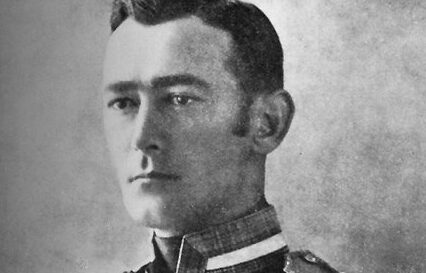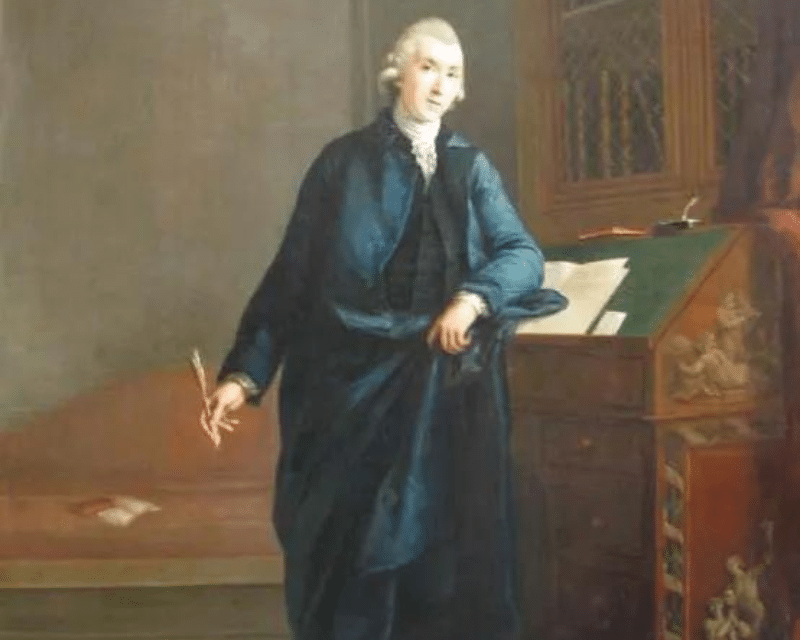- Collected
- Article
Forgotten Hero
A tale of guile and derring-do from the annals of World War I

- 31 August, 2015
- Roy Bainton
It can be strange the way writers sometimes accidentally stumble into a story. In 1999, my career as a full-time writer barely two years old, I was invited by an academic friend at the University of Kalmar, in Sweden, to visit the country to meet a marine archaeologist, Björn Axel Johansson, who was working on a potential TV documentary about wrecks at the bottom of the Baltic Sea.
That night in Kalmar we visited a Chinese restaurant, drank copious amounts of beer, and ambled back through silent, snow-clad streets to Björn’s warm, comfortable apartment. Over yet more beers he produced a VHS tape and slotted it into the player. It contained enthralling footage, taken by Kalmar’s diving team, of various wrecks. In one World War I wreck’s cabin, through the clear water, the divers’ lamps eerily illuminated a very well-preserved bunk with the captain’s sea boots still standing in a corner.
I asked how this was possible. Björn explained. The Baltic is a small and shallow sea. Its unique feature is its brackish water (a mixture of fresh water and seawater) which means that wooden wrecks, often quite ancient, remain well-preserved, given the absence of shipworms which infest other oceans. Iron and steel wrecks also look remarkable, without the intense encrustation of organisms you see in the much deeper Atlantic or Mediterranean.
We watched shots of four wrecks in a sequence before Björn pointed out that all these vessels had been sunk on a single day in October 1915 by one British submarine. I was intrigued. I asked him if he knew which submarine had wrought such destruction. He searched his files. It was HMS E19.
The TV documentary never happened. Back in the UK, in an attempt to salvage something from the trip, perhaps a magazine feature, I telephoned the Royal Navy Submarine Museum in Gosport. I asked if they had anything on HMS E19. The curator replied ‘Yes, a couple of pages. But would you like to see the service record of her captain?’ I asked, ‘Why — is he interesting?’ She replied, rather slowly and cryptically: ‘Oh, yes, indeed…without a doubt.’
Two days later, the contents of a large manila envelope insinuated the heroic spectre of a murdered man into my writing life — and he’s been at my shoulder, like a spirit pursuing redemption, ever since. I had found a handsome, brave, intelligent and neglected hero, Captain Francis Newton Allen Cromie, CB, DSO, RN, but what was I to do with him?
Born in Ireland in 1882, educated in Wales, Cromie saw his first action with the Naval Brigades during China’s Boxer Rebellion, aged 18. By 24, he was in command of a submarine, and had received the Royal Humane Society’s Bronze Medal for saving a drowning sailor washed overboard in the English Channel. Teetotal and non-smoking, Cromie was a skilled watercolour artist, musician, orator, singer and raconteur. He was loved by his crews; and during the Bolshevik Revolutions, he became a consummate mediator in many dangerous confrontations.
Until Lenin arrived back in Russia on his sealed train, the new submarines of Britain’s Royal Navy were fully occupied in the Baltic, fighting alongside the Tsar’s Imperial Navy, and the sailors of both forces looked up to Cromie. In September 1915, he took command of HMS E19 and two other submarines, entering the Baltic to join the Royal Navy’s sub flotilla based in Reval (today’s Tallin).
On 3 October, HMS E19 set out on a voyage of destruction and, on one day alone, Cromie sank five ships in the Baltic Sea. Another nine went down before 2 November; on 7 November E19 added the German cruiser Undine to its casualties, topping off a successful patrol on 4 December by despatching the 1300-ton freighter, Friesenberg. With the frigid Russian winter setting in, further action in the frozen Baltic was curtailed until the spring.
Tsar Nicholas II visited Reval on the Royal Train and awarded Cromie one of Russia’s highest honours, the Order of St. George (equivalent to the VC). In 1916 he would receive the DSO from the Admiralty, and later the Legion of Honour from the French. Cromie took overall command of the Reval Flotilla, and he and his 200 sailors were fêted wherever they went. He soon mastered the Russian language. In a speech made to assembled actors, poets and musicians in a Moscow Theatre, he said (to a standing ovation):
You are all artists — musicians, poets, novelists, painters, composers: you are creators. What you create will live long after you. We are simple sailors. We destroy. But we can say truthfully that in this war we destroy in order that your works may live.
The British contingent shared their accommodation in the long Baltic winter, the sea being impassable, with the Russian Navy on board an old warship, the Dvina. In March 1917, the Bolshevik Revolution underway, the Tsar’s navy mutinied, murdering over 1,200 of its officers. Cromie’s skill as a mediator saved many naval and civilian lives. In 1918 Trotsky signed the Treaty of Brest-Litovsk, which brought Russia out of the conflict, making Cromie’s flotilla surplus to requirements.
The White Finns offered Cromie a personal sum of £50,000 to prevent Red Sailors from entering Helsinki, and ‘dealt’ with their own Bolsheviks ashore. He refused the offer. The Treaty of Brest-Litovsk stipulated the surrender of Cromie’s flotilla to the Germans. The Finnish business community offered him a personal fortune of £5 million for his seven boats. He refused, sailed the seven submarines into the Gulf of Finland and in the sight of the advancing Germans, scuppered the whole flotilla. His 200 men were then sent home on a gruelling ten-day train journey to join a UK-bound ship in Murmansk.
Cromie, though married, was carrying on an affair with a young Russian socialite, Sonia Gagarin. He became a regular figure at Petrograd’s British Embassy, staying behind once his men had gone home to fight his clandestine war against Germany single-handed. Cromie was always the charming ladies’ man. He went about with two Baronesses, Baroness Schilling and the enigmatic double agent, Moura Budberg, great-great-aunt to Nick Clegg. Yet Sonia Gagarin was his true Russian love. Baroness Budberg, meanwhile, fell hopelessly in love with H. G. Wells.
Soon the murky world of espionage, where Cromie was out of his depth, would engulf him, as the Allies secretly planned military intervention against Lenin. Among Cromie’s cloak-and-dagger associates was the duplicitous ‘Ace of Spies’, Sidney Reilly, the inspiration for Ian Fleming’s 007. Following a carefully planned ‘sting’ by agents of the Cheka, (forerunner of the KGB) the British Embassy was raided by Red Guards on 31 August 1918. Cromie, pistol in hand, defending his last outpost, was shot dead on the building’s grand staircase. He was 36.
Under suspicion of being complicit in Allied counter-revolutionary plans, the majority of British nationals in Petrograd were arrested and thrown into the Peter & Paul Fortress. With no one to arrange Captain Cromie’s funeral, the neutral Dutch and Swedes stepped forward to give a brave man a proper burial. When his ragged, ad hoc cortège passed along the banks of the Neva, en route to Petrograd’s Smolensky Cemetery, lounging sailors on the decks of the moored Russian destroyers of the new Soviet navy, suddenly realising whose funeral this was, spontaneously formed ranks and gave him a final salute.
Churchill praised Cromie as ‘a man of great ability’, and The Times carried a short report of his death. Cromie was posthumously awarded Companion of the Order of Bath (CB) from King George V, which was collected by his widow Gwladys at a special investiture at Buckingham Palace.
Writing Cromie’s biography, Honoured By Strangers was a tough job. Clues were thin on the ground. I spent two weeks in Russia visiting relevant locations. In the old British Embassy, which now houses the St Petersburg University of Arts and Culture, staff and students were drop-jawed as I told them Cromie’s story, and the grand marble staircase still had the impact marks of the bullets fired on that fateful day.
The book got a number of rave reviews, then vanished as the publisher, Airlife of Shrewsbury, went into liquidation. I retained the rights to the book but it has taken 14 years for it to be reissued as an e-book. Throughout that time, I was determined to see Cromie’s story presented to the public. Saga magazine ran it as a two-part feature, funding my trip to Russia. BBC History Magazine ran a feature. I’ve had countless meetings with TV production companies in the hope of a documentary, all fruitless. I’ve tried Max Hastings, the History Channel, Channel 4, BBC TV and radio, even sending the book to Jeremy Clarkson. The only decent, gentlemanly response came from Private Eye’s Ian Hislop, who had the good manners to write and explain that he found it fascinating, but was ‘too busy’.
So here we are in the midst of a media orgy of Great War centennial documentaries, and I ask this question: a handsome hero, submarine warfare, an illicit love affair, the Bolshevik revolution, espionage, and murder: what’s not to like? I’ve done all the hard work. There’s plenty of material, brilliant locations, hundreds of potential screenshots. But nobody’s interested. I’ve even written the screenplay.
Perhaps this particular hero is fated to remain neglected. A poignant coda; his heartbroken Russian lover, Sonia Gagarin, moved to the USA and married a Russian émigré called Rostkovsky. She died, childless and alone, in Baton Rouge, Louisiana, in 1979. She would never visit Russia again, and unless some creative director spots this story in time for the centennial of her lover’s murder in August 2018, neither shall I.
You might also like:
The Life and Times of Reverend David Williams
As we get ready to celebrate our 234th anniversary on 18 May, a recent RLF grant beneficiary takes a deep…
Anywhere But a Room of One’s Own
I am a writer looking to be re-homed. All I need is a laptop, a table and a chair, and…
RLF Fellows’ News: May 2024
Publishing RLF Fellow Tom Lee’s new book, The Bullet, his memoir about family and mental health, has recently been published…


